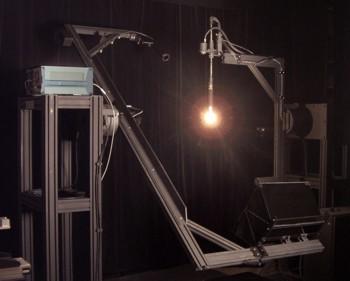NIST Gonio-spectroradiometer

The NIST gonio-spectroradiometer is used to measure total spectral radiant flux (TSRF) of incandescent lamps. The instrument consists of a 3-axis scanning mechanism; an array spectroradiometer equipped with a fast, cooled (-10oC) charged-coupled device (CCD), and a computer system that controls the instrument's motion and acquires data.
The short arm of the 3-axis scanning mechanism is used to set up the lighting orientation of a test lamp. The long arm rotates the irradiance head of the spectroradiometer around the θ axis. And, the lamp holder rotates around the φ axis. The dead angle of θ is ± 3 degrees due to the mechanism of the lamp holder (that is, 0o < θ < 177o). The scanning motors for both θ and φ axes stop when a measurement occurs. For a scanning angle interval of 10o for both θ and φ, the total time for measuring a test lamp is approximately one hour.
On the long arm of the 3-axis scanning mechanism, an irradiance head with approximate cosine response (a UV transmissive diffuser with diameter of 15 mm) is mounted to end and has a rotation radius for θ of ≈1.25 m. Errors from scattered ambient stray light are minimized with a hood mounted on the irradiance head to limit the field of view within the light trap mounted on the other end of the long arm.
Attached to the fixed frame of the gonio-spectroradiometer is the CCD array spectroradiometer. A 5 m quartz fiber bundle couples the rotating irradiance head to the stationary array spectroradiometer. The twisting effect of the fiber bundle on the responsivity of the spectroradiometer was tested to be less than 0.1 %. Two spectral irradiance standard FEL lamps are used to calibrate the spectroradiometer with the arm of the irradiance head oriented horizontal (θ = 90°).
Nonlinearities in the signal and errors from spectral stray light have been characterized and corrected for the spectroradiometer. Corrections are applied for all measurements. This includes the standard FEL lamps measurements (for relative spectral irradiance responsivity calibration) and the test lamp measurements at every viewing angle.

